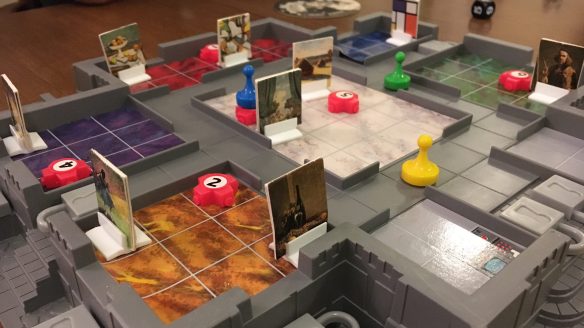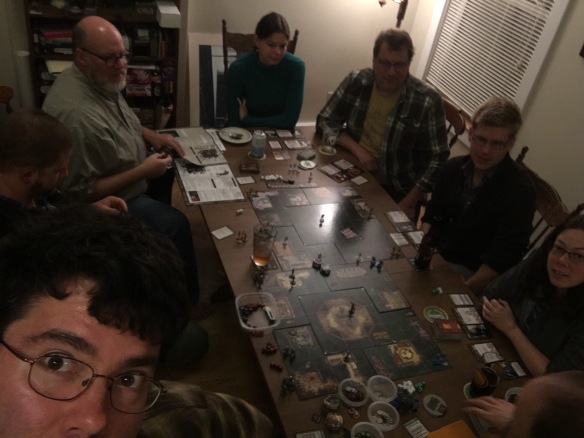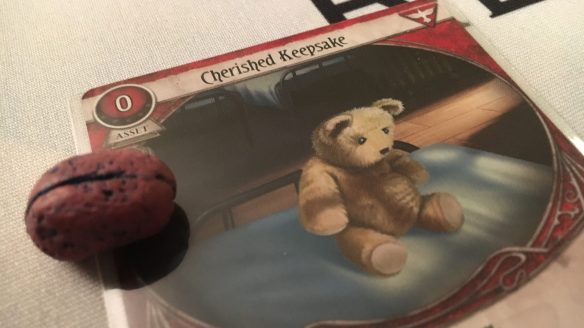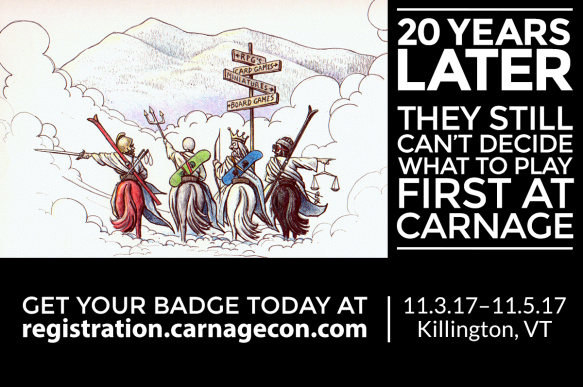Making last year’s Top Plays of 2015 post a tradition, it’s time to count down my most played board games of 2015! You can see everything I played, tabletop-wise, over on BoardGameGeek. And stay until the end, because at the end of the list, I set myself some hobby-related goals for 2017.
While most of my tabletop time in 2016 was been spent on board and card games, I did manage to up my role-playing a little bit. There was the stop-and-start campaign of Skull & Shackles, sadly more stopped than started, and a biweekly playthrough of The Dracula Dossier for Night’s Black Agents. I continue to hope that next year will be the year that I get more regular role-playing opportunities, and I have some thoughts on how to achieve that.
That said, on with the countdown, from least plays of 2016 to the most.
5. Betrayal at House on the Hill
That perennial favorite of mine, the haunted house-building, cheesy horror movie tribute game Betrayal got a richly deserved expansion this year, called Widow’s Walk. The prospect of experiencing new haunts helped me get in six plays of the game in 2016, though maybe half of those came after the expansion’s release. Probably my most memorable session of the game remains playing through “The Manor of Your Demise” and teasing out just how deep down the rabbit hole one can go.
4. Codenames
Codenames is the second newest game to make this list. It’s a party-sized game, where two teams try to figure out what the hell the spymaster means by “Blue 2” and other clues meant to help them pick out specific words from a grid of options. It’s also one of those games where you can rack up a lot of plays in one or two sittings as teams shuffle around, or someone tries to reclaim their dignity after a poor turn as the spymaster. Of my seven plays of Codenames, I struggled as the spymaster every time I was in the hot seat.[1]
3. Arkham Horror: The Card Game
The most recently published entrant on the list, the Arkham LCG was my only — and thus most — anticipated game to play in 2016 since news first slipped out in April. The blend of cooperative play and the Cthulhu mythos really appealed to me. I’m reasonably certain I’m on record in at least a couple Decked! episodes or comments noting I played Arkham‘s predecessor primarily for the theme, rather than the thrill of competitive play.
I don’t know yet if Arkham has staying power for me, but experiencing the design of the Curse of the Rougarou standalone expansion did far more to convince me I would enjoy playing this game than the introductory scenarios in the core set did. It seems very likely I’ll get in more sessions in 2017 than the eight I managed in 2016.
2. Call of Cthulhu: The Card Game
It will surprise no regular reader of Held Action that I have played quite a few games of the Call of Cthulhu living card game, going so far as to make videos of them for the internet’s delight. The Cthulhu LCG is my all-time most played game on BoardGameGeek, with 189 matches logged. In 2016, however, Call of Cthulhu slipped to second place for plays of 2016. I “only” got in 10 matches, and that was probably thanks in large part to at least one “you people need to buy all the extra packs I ordered” draft event at Black Moon Games in Lebanon.
Since Fantasy Flight stopped publishing new cards — and yes, the game is still enjoyable without a constant stream of new material — that put a major damper on the local play group making the time to get together. I’d love to play more — and still have yet to make substantial use of anything from The Mark of Madness — but I anticipate this game being in direct competition with the Arkham LCG for time and attention. The local play rosters for the two games are almost identical and we are all working stiffs with a limited amount of time on our hands. So it goes.
1. Sentinels of the Multiverse
And as the Call of Cthulhu LCG slips from first, so does Sentinels of the Multiverse rise to take the crown. This is the title that people at area game nights have come to expect to see me toting. I introduced my friend Margot to the game this year, and she took to quite readily, so the list of people who are almost always up for a game of Sentinels is slowly growing.
While I got in 11 plays of the ink and cardboard version of Sentinels this year, I logged far, far more time playing the digital version. I took advantage of free time over the holidays this year to knock out the achievements a solo player can attain, including all the story challenge achievements for unlocking variant character cards.[2] All that remains is the achievement to play with Handelabra or Greater Than Games, or someone who’s played with them.
Sentinels has been the game that occupied most of my attention in 2016. Handelabra Games launched a phone-friendly version of the game, giving me something to do during downtime out and about — I knocked out a quick game waiting for Rogue One to begin last week, for instance. The weekly one-shot challenges became the feature of Decked! episodes. Greater Than Games raised funds for the game’s final expansion and host of bonus content, which also helped reinvigorate my interest in the game.
Tabletop Goals for 2017
I’d like to start a new part of this end of year post tradition: setting some play goals for the year to come. In no particular order, I would like to:
- Get in more plays of the games I own and enjoy. Eldritch Horror has yet another big box expansion on the way and I have barely scratched the surfaces of the Strange Remnants, Under the Pyramids and Signs of Carcosa expansions. Likewise, there is so much more of Widow’s Walk to play.
- Play more role-playing games. Dracula Dossier is my regular game at the moment and as one that’s played on the weekend, there are often things that get in the way of everyone making it. I’d like to find or start a regular game on a week night that isn’t already crammed on everyone’s calendar. By some twist of synchronicity, everyone in Chittenden County thinks Tuesday is the optimal night to play games, which means there’s a plethora of choice, but not a lot of crossover as people commit to one place and set of players.
- Find and create my next big game-related project. I’ve produced a podcast. I’ve made YouTube play videos through Decked! I like to produce game-adjacent content, it seems, and I would like to find a new endeavor or area of interest to focus on, like I have with Cthulhu commentary and Sentinels one-shots in the past. I don’t know what shape that might take yet, but I’ve been giving it thought and hope to come up with a fun project for 2017.
[1] Almost as much as playing the ghost in Mysterium.
[2] In fact, Steam’s telling me I spent almost 70 hours on the game in the last two weeks, though I’m not sure if that’s total time the game application was open, or time where I was moving the mouse and clicking things.









